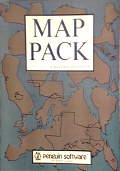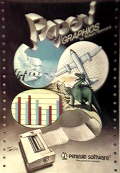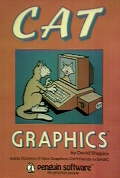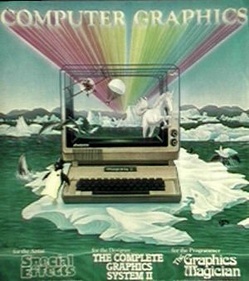More Graphics Software
With the success of the original trilogy of graphics programs, other software writers began sending their graphics programs to us to add to the product line. We'd been successfully using "The Graphics People" as our slogan, and most of these new ideas from others added to our list of firsts in personal computing.
 From New York, Andre Schklowsky sent us a slide-show program called
Transitions. It let you arrange and organize a series of images into a slide
show, complete with a wide variety of transitions, or "wipes", between slides. This was
likely the first "presentation" software ever published for personal computers!
From New York, Andre Schklowsky sent us a slide-show program called
Transitions. It let you arrange and organize a series of images into a slide
show, complete with a wide variety of transitions, or "wipes", between slides. This was
likely the first "presentation" software ever published for personal computers!
 Transitions manual
Transitions manual
 Transitions DSK archive
Transitions DSK archive
 Also from New York, Howard Rubin and Mark Fisch convinced us to market
what turned out the be the first computer clip-art collection. We have to give him credit,
since he foresaw what would soon become a nice little niche market of its own. Howard had a
lot of ideas of how to expand the concept, but we were skeptical. He convinced us to
publish a series of clip-art maps as Map Pack. A few years later, with
Macintosh's creation of a new field called "desktop publishing", computer clip-art would
become an industry of its own.
Also from New York, Howard Rubin and Mark Fisch convinced us to market
what turned out the be the first computer clip-art collection. We have to give him credit,
since he foresaw what would soon become a nice little niche market of its own. Howard had a
lot of ideas of how to expand the concept, but we were skeptical. He convinced us to
publish a series of clip-art maps as Map Pack. A few years later, with
Macintosh's creation of a new field called "desktop publishing", computer clip-art would
become an industry of its own.
 We also published one of the first collections of fonts, which could be
used with Complete Graphics System to overlay text onto graphics screens. Most of
the fonts in this set were actually distributed earlier by the Apple Pugetsound Program
Library Exchange (A.P.P.L.E.), but we converted them to our format, and sold it separately
to replace the "ugly font" Mark had created to put in the original CGS. True story: we were
exhibiting at a trade show in the Superdome in New Orleans. We looked up, and messages
were being displayed on the hanging Superdome scoreboard, and the typeface used for the
messages was undoubtedly our original distinctively ugly "ugly font"! Someone had
apparently transferred the original CGS typeface and was using it for the Superdome. We
wondered if it was still in use a year or so later when the Bears won the Super Bowl there
in '85...
We also published one of the first collections of fonts, which could be
used with Complete Graphics System to overlay text onto graphics screens. Most of
the fonts in this set were actually distributed earlier by the Apple Pugetsound Program
Library Exchange (A.P.P.L.E.), but we converted them to our format, and sold it separately
to replace the "ugly font" Mark had created to put in the original CGS. True story: we were
exhibiting at a trade show in the Superdome in New Orleans. We looked up, and messages
were being displayed on the hanging Superdome scoreboard, and the typeface used for the
messages was undoubtedly our original distinctively ugly "ugly font"! Someone had
apparently transferred the original CGS typeface and was using it for the Superdome. We
wondered if it was still in use a year or so later when the Bears won the Super Bowl there
in '85...
 Typesets insert, 1984
Typesets insert, 1984
 Additional Typesets DSK archive
Additional Typesets DSK archive
 Back in those days, printers were a problem. Today, the printer
manufacturer is responsible for the print drivers, and often they are included with the
operating system. Back then, the printer came with a manual. Period. There were dozens and
dozens of printers that worked with the Apple II, and they were all different, so printing
graphics was a REAL hassle. Robert Rennard assembled a very nice series of print drivers
tied to a printing program we called Paper Graphics. It seems funny today that
you'd have to buy separate software to be able to print other than text. I'm sure
eventually all of these "add-ons" would have been marketed together as one integrated
package, as they are now. But back then the problem with integration was disk and memory
size. The Complete Graphics System (which as you can see became less "complete" as
we progressed) already pushed the maximum limits of both. There was no easy way to
"integrate" more into the package until memory and disk capacity increased!
Back in those days, printers were a problem. Today, the printer
manufacturer is responsible for the print drivers, and often they are included with the
operating system. Back then, the printer came with a manual. Period. There were dozens and
dozens of printers that worked with the Apple II, and they were all different, so printing
graphics was a REAL hassle. Robert Rennard assembled a very nice series of print drivers
tied to a printing program we called Paper Graphics. It seems funny today that
you'd have to buy separate software to be able to print other than text. I'm sure
eventually all of these "add-ons" would have been marketed together as one integrated
package, as they are now. But back then the problem with integration was disk and memory
size. The Complete Graphics System (which as you can see became less "complete" as
we progressed) already pushed the maximum limits of both. There was no easy way to
"integrate" more into the package until memory and disk capacity increased!
 David Shapiro (alias "Dr. Cat") wrote Cat Graphics, a collection
of "ampersand" extensions that gave people lots of neat graphics functions from BASIC.
Applesoft BASIC had this neat ampersand operator that could be used to
extend the language. Dave's functions worked in both standard hi-resolution (6 colors) and
the new double hi-resolution (16 colors!). Dave came to work for the company for a while,
and wrote some of the Commodore 64 game translations that we published.
David Shapiro (alias "Dr. Cat") wrote Cat Graphics, a collection
of "ampersand" extensions that gave people lots of neat graphics functions from BASIC.
Applesoft BASIC had this neat ampersand operator that could be used to
extend the language. Dave's functions worked in both standard hi-resolution (6 colors) and
the new double hi-resolution (16 colors!). Dave came to work for the company for a while,
and wrote some of the Commodore 64 game translations that we published.



